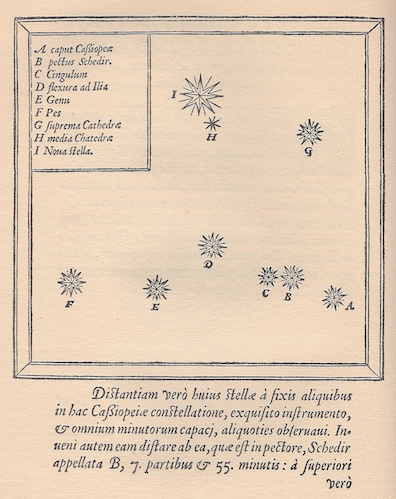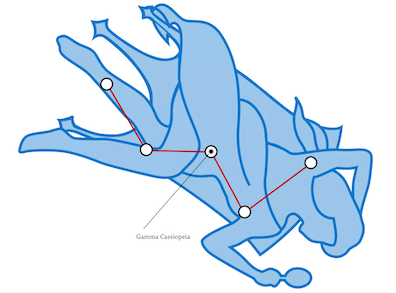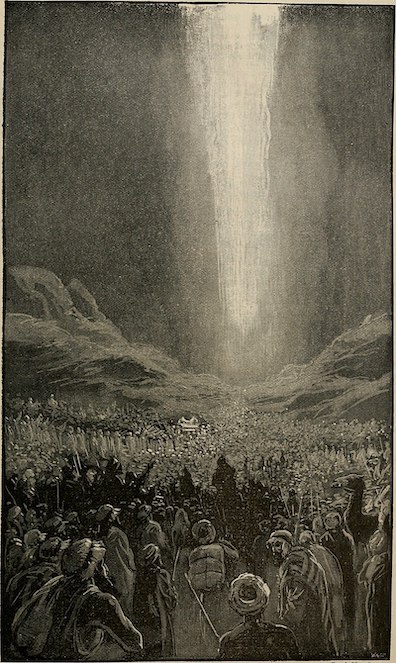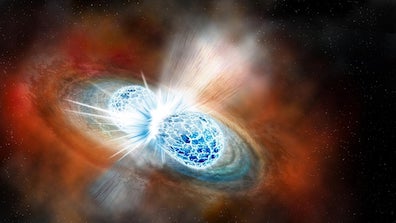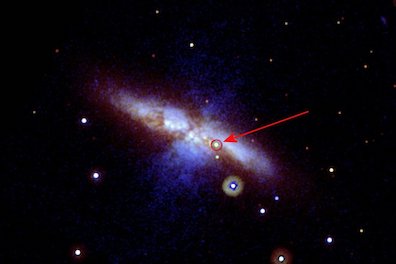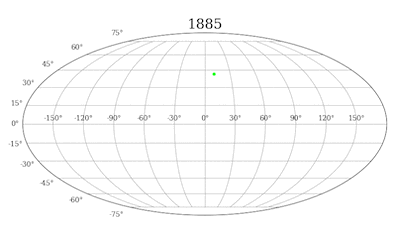The delta star in the familiar W-shaped constellation of
Cassiopeia is actually a binary system (two orbitally locked
stars, a phenomenon which Ithaca calls "the
interdependent gyrations of double suns") that lies
about 100 light years from Earth in the Milky Way galaxy. In
the first few days of November 1572, various observers noticed
a new star near this old one. The nova grew steadily brighter
until, on November 16, it exceeded the brightness of the
planet Venus and could be seen by the naked eye in daytime.
About a year and a half later, it faded from view. In 1573 the
Danish astronomer Tycho Brahe published a book titled De
nova et nullius aevi memoria prius visa stella ("On the
new, and never before seen in anyone's life or memory, star").
His small tome gave rise to the term "nova," and today the
exploded star seen near delta Cassiopeia is often called
Tycho's Supernova. Its remnants, less than 10,000 light years
away (also in the Milky Way), were discovered by radio
telescope in the 1950s.
The nova seized people's imaginations in the 16th century not
only because of its brightness but because such things were
not supposed to happen. In the regular, clocklike movements of
the heavens, novel and unexplained dynamic phenomena like
meteors and comets often caused alarm and were interpreted as
baleful omens. But such relatively nearby occurrences were
encountered relatively often. Farther out from earth, such
changes were seldom seen and Scholastic philosophers even
asserted that they were impossible. Aristotle had written that
beyond the sphere of the moon the heavens appeared to be
changeless, and his speculation had hardened into an
inflexible doctrine that planets and stars are made of
different stuff than our perishable phenomena. Stars simply
could not come into or pass out of being. Now one had done so,
and Tycho, observing that its position did not change parallactically, argued that
it must lie far beyond the orbit of our moon.
In Proteus Stephen seems to associate this evidence
that the heavens are as mutable as the earth with a comparable
idea advanced in the late 16th century: Giordano Bruno's
argument that the universe is full of worlds like our own.
Bruno (1548-1600), who was almost exactly contemporary with
Tycho (1546-1601), was more a cosmographer than an astronomer.
As far as I am aware the 1572 nova did not directly influence
his thinking, but it might certainly have encouraged it. In a
1584 work titled De L'Infinito Universo e Mondi ("On
the Infinite Universe and Worlds"), Bruno argued that
Copernicus' heliocentric theory was correct, that the sun was
just one of an infinite number of similar heavenly bodies,
that planets like ours revolved around many of those stars,
and that inhabited "worlds" might exist throughout the
universe. For his troubles the church had him stripped naked
in the streets, fitted with a muzzle, and burned alive. (In
his diary at the end of A Portrait, Stephen records a
conversation with one of his Jesuit
instructors, Father Ghezzi, about "Bruno the Nolan": "He said
Bruno was a terrible heretic. I said he was terribly burned.
He agreed to this with some sorrow.")
Sitting on the seawall rocks, Stephen thinks of the "roar of
cataractic planets, globed, blazing, roaring
wayawayawayawayawayaway," and then wonders whether planets
like our own may exist throughout the universe: "Why not
endless till the farthest star? Darkly they are there behind
this light, darkness shining in the brightness, delta of
Cassiopeia, worlds." On one of these Brunonian "worlds,"
he supposes, another Stephen may sit looking up at stars never
seen from Earth: "Me sits there with his augur's rod of ash,
in borrowed sandals, by day beside a livid sea, unbeheld, in
violet night walking beneath a reign of uncouth stars." The
fanciful conceit reflects Bruno's belief in the transmigration of souls.
Stephen's fantastical star-fictions continue in Scylla
and Charybdis, now drawing on popular reactions to the
nova. As Gifford observes, "The supernova caused considerable
imaginative excitement in Elizabethan England as a sort of
Star of Bethlehem, heralding a new birth, the second coming of
Christ." In Stephen's telling it heralded the coming of
Shakespeare: "What's in a name? That is what we ask ourselves
in childhood when we write the name that we are told is ours.
A star, a daystar, a firedrake, rose at his birth. It shone
by day in the heavens alone, brighter than Venus in the
night, and by night it shone over delta in Cassiopeia,
the recumbent constellation which is the signature of his
initial among the stars." Cassiopeia is said to be a
seated queen combing her hair, though the five stars do not
really suggest any such shape. Seen as a W, Shakespeare's
"initial," the woman is "recumbent"—lying prone. Stephen no
doubt imagines Shakespeare thinking of some similar position
recently adopted by Anne Hathaway in her bed.
The connection between terrestrial and celestial affairs
intimated in Proteus persists in this and other
details. "Firedrake" was one name for meteors in Shakespeare's
time, and Stephen implies that like meteors the nova held
portentous significance for earth-dwellers. In particular, its
appearance near a gigantic W inscribed in the heavens gave
young William an occult hint of his greatness. Puzzled by the
reference, Thomas Lyster asks, "Was it a celestial
phenomenon?," and Stephen suggests that the nova was a
cosmically ordained sign: "— A star by night, Stephen
said. A pillar of the cloud by day." He is recalling
God's leading of his people through the desert in Exodus
13:21: "And the Lord went before them by day in a pillar of a
cloud, to lead them the way; and by night in a pillar of fire,
to give the light; to go by day and night."
Stephen's claim is not only outlandish; it is
self-consciously sophistic. Shakespeare was born in 1564, so
it can hardly be said with accuracy that the new star "rose
at his birth." (Given Cassiopeia's perpetual presence in
the northern sky, it would not even have risen!) Nor can it be
said with accuracy that Shakespeare might have watched the
nova during the period of his infatuation with Anne Hathaway:
"His eyes watched it, lowlying on the horizon, eastward of the
bear, as he walked by the slumberous summer fields at midnight
returning from Shottery and from her arms." There is no need
for Stephen to make this claim, and his interior monologue
shows that he knows it to be false: "Don't tell them he was
nine years old when it was quenched." Or that he was
eight years old when it first appeared, he might well add. His
knowledge of the relevant dates is good, but his biography is
a cynical fraud.
In Ithaca, standing outside 7 Eccles Street gazing at
constellations with Bloom, Stephen's astronomical conversation
piece becomes amplified with some scientific details that one
imagines must come either from Bloom or the narrator. The two
men are said to have discussed "the appearance of a star
(1st magnitude) of exceeding brilliancy dominating by night
and day (a new luminous sun generated by the collision and
amalgamation in incandescence of two nonluminous exsuns)
about the period of the birth of William Shakespeare over
delta in the recumbent neversetting constellation of
Cassiopeia." Perhaps Stephen does know (despite his
earlier statement that the star "rose") that Cassiopeia is
"neversetting." From northern latitudes like Dublin's, the
constellation's orbit around Polaris is circumpolar, never
dipping below the horizon. The information in parentheses,
however, seems beyond his ken.
Star "magnitude" has been mentioned earlier in the
same paragraph. In the reverse-order scale devised in
antiquity, magnitude 1 stars were the brightest in the sky,
and magnitudes "up to and including the 7th" were
visible to the naked eye. (Authorities would disagree with
"and including." Perhaps Bloom is bragging about the power of
his night vision.) After the scale was regularized and made
logarithmic in 1856, negative numbers were introduced to
account for brighter objects, so that Sirius now has a
magnitude of -1.46, and the sun -27. By this way of measuring,
the planet Venus is brighter than -4, so the 1572 nova might
have ranked almost -5.
The "collision" of two stars was one theorized
explanation, still current in 1904, of how novae happened.
Today, different causes are proposed: gravitational collapse
in the core of a massive star, or runaway nuclear fusion in a
white dwarf. But stellar collisions can produce tremendous
explosions, creating heavy elements from gold and platinum to
uranium (supernovae normally produce no elements heavier than
iron), and it is thought that they may sometimes trigger
runaway fusion in white dwarfs.
The narrative in Ithaca reports that the two men
spoke also "of a star (2nd magnitude) of similar
origin but of lesser brilliancy which had appeared in and
disappeared from the constellation of the Corona
Septentrionalis about the period of the birth of Leopold
Bloom and of other stars of (presumably) similar origin
which had (effectively or presumably) appeared in and
disappeared from the constellation of Andromeda about the
period of the birth of Stephen Dedalus, and in and from the
constellation of Auriga some years after the birth and death
of Rudolph Bloom, junior, and in and from other
constellations some years before or after the birth or death
of other persons." These were actual sightings of novae.
In May 1866 one appeared in Corona Borealis (the Northern
Crown, also called Corona Septentrionalis) and grew to
magnitude 2. Another was spotted in the constellation
Andromeda on 17 August 1885 and reached magnitude 5.85 four
days later, before rapidly fading. Still another appeared in
the constellation Auriga in 1891 and was observed at peak
brightness in January and February 1892, when it had an
apparent magnitude of about 4.5.
The science is good, then, but the effort to link novae to
people's birth dates displays the same tendentious
inexactitude encountered in Scylla and Charybdis. The
first seems close enough: Bloom was born in 1866, though the
novel never specifies a month or day. Stephen, however, was
presumably born, like Joyce, in early 1882, three and a half
years before the sighting of the nova in Andromeda, and Rudy
was born at the end of 1893, two years after the Auriga nova
appeared.
What is going on with this proliferation of novae loosely
connected to the births of characters in the book? Reading
between the lines, as one must do constantly in Ithaca,
it seems likely that Stephen has volunteered his heavily
mythologized astronomical tidbit and Bloom, who possesses some
actual knowledge of astronomy, has responded by naming several
other novae. If Stephen, showing Bloom an honesty he did not
display in the library, has said that Tycho's new star
appeared "about the period of the birth of William
Shakespeare" (emphasis added), then Bloom, gamely playing
along, may have chosen to mention novae that appeared within a
few years of the births of himself, Stephen, and Rudy, as well
as others seen "after the birth or death of other persons" who
are not specified.
Supernovae—the term was coined about a decade after the
publication of Ulysses—were just beginning to be
intensively studied in the second half of the 19th century.
Although they are thought to occur only about twice a century
in the Milky Way (and not all are observed, because of
intervening objects), the development of better and better
telescopes has allowed astronomers to observe them in many
distant galaxies, exponentially increasing the rate at which
they are discovered, as the GIF file here graphically
illustrates. It is now known that supernova explosions often
result in nebulae,
themselves known to produce stars, planets, worlds.
Joyce and his astronomical persona Bloom are onto something
big.

